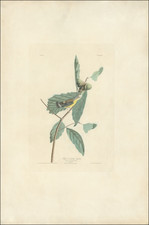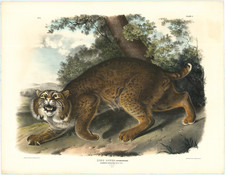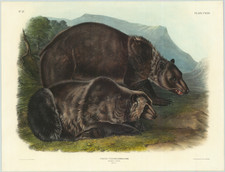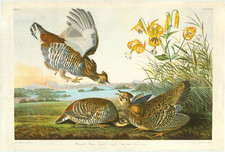This original double-elephant folio aquatint by John James Audubon presents a vivid portrayal of two Surf Scoters against the backdrop of their coastal environment.
The adult male, on the left, is captured in a moment of animation; his stance on a rock is commanding, with his dark plumage stark against the pale sky. His distinctive white eye patch and the strikingly colored bill, unique to the male of the species, are depicted with precise detail, and his open beak suggests a call into the surrounding stillness.
Nearby, the female Surf Scoter embodies repose as she sits on the beach. Her brownish, mottled plumage blends more subtly with the natural tones of the sandy shore, reflecting the typical coloration of females, which provides camouflage. Her calm demeanor is offset by a gaze that conveys a sense of watchfulness.
Between them, two clamshells lie on the ground, as if just discarded by the tide, symbolizing the ducks' foraging habits and the richness of the marine life that sustains them. The scene is tranquil, with the serene sea and distant cliffs painting a picture of the quiet life these birds lead, interspersed with moments of activity and interaction. Audubon's work combines scientific accuracy with an artistic eye, bringing to life the essence of the Surf Scoters in their natural habitat.
John James Audubon's Double Elephant Folio Birds of America: The Havell Edition (1827-1838)
The present hand-colored original Audubon print comes from the Havell double elephant folio edition of Birds of America, the greatest color plate book ever made. This work was Audubon's magnum opus and was published at immense expense over almost a decade, between 1827 and 1838. The Havell Edition of Birds of America included 435 hand-color aquatinted plates, and it is estimated that between 165 and 175 complete sets were produced. Today, a given individual image probably exists in no more than 60 loose examples, though for some plates the number will be much lower. Audubon aquatint engravings from the Havell Edition were printed on J. Whatman wove paper, the best paper in the world at the time - and to this day an exceptional fine art paper. The sheets of paper were approximately 26½ x 39½ inches untrimmed. Importantly, they all feature watermarks that are variations on "J.Whatman" or "J.Whatman / Turkey Mill" with the date of manufacture sometimes appended. In addition to the name of the bird depicted (and sometimes its gender, age, and botanical notes as well) Audubon's name and the name of the engraver also appear printed on Havell Edition plates. On the lower left side is printed "Drawn from nature by John James Audubon F.R.S. and F.L.S." (Fellow of the Royal Society of London and Fellow of the Linnaean Society). The only exception to this is Plate 64, Swamp Sparrow, in which Lucy Audubon is credited. On the lower right side is printed "Engraved by" (in a few cases the words "Engraved and colored by" or "Retouched by" appear) followed by the name W.H. Lizars or Robert Havell, Jr. (Sometime after his father's death in 1832 Robert Havell, Jr. dropped the Jr.)
John James Audubon (1785-1851), born Jean-Jacques Rabin in Haiti on April 26, 1785, was a Franco-American ornithologist, naturalist, and painter, celebrated for his detailed illustrations of North American birds in their natural habitats. His major work, a color-plate book titled The Birds of America, is considered one of the finest ornithological works ever produced.
Audubon's early years were shaped by tumultuous events. Born out of wedlock in the French Caribbean colony of Saint-Domingue (now Haiti) to a Creole mother and a French sea captain, he was smuggled to Nantes, France, during a slave rebellion. There, he was adopted by his father and stepmother and raised as their own. His childhood in France was filled with outdoor adventures and initial forays into drawing.
In 1803, to avoid conscription into Napoleon's army, he was sent to America, where he managed one of his father's estates near Philadelphia. This move further kindled his profound interest in the wildlife of the New World. Despite a few failed business ventures and challenges, Audubon remained committed to his passion for nature and art.
His dream to document all of the birds of America began to take form in the 1810s. Travelling through America's wilderness, Audubon observed, hunted, and painted birds. He developed a particular technique that involved wiring freshly killed birds into a natural pose on a board. This innovative method combined with his keen observation allowed him to create more lifelike illustrations than many of his contemporaries.
Failing to secure American subscribers or a publisher for his extensive collection, Audubon traveled to the United Kingdom in 1826. There, The Birds of America was met with critical acclaim. Between 1827 and 1838, this work was published in sections, comprising 435 hand-colored, life-sized prints made from engraved plates.
Audubon followed this success with a companion work, Ornithological Biography, which provided detailed narratives about each species. His later work included studies of American mammals, and he became one of the founding members of the New-York Historical Society.
Despite facing numerous challenges throughout his life, including financial hardships and criticism from some peers, Audubon's dedication to his work resulted in an invaluable contribution to ornithology and American art. He died on January 27, 1851, in New York City. Today, his legacy continues, notably through the National Audubon Society, which promotes conservation and appreciation of birds and their habitats.











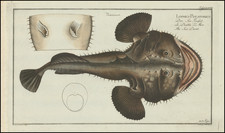
![The Cocatoo, or white Parrot, a Native of several of the Malay Islands. full size. [Original watercolor of a sulfur-crested cockatoo.]](https://storage.googleapis.com/raremaps/img/small/103913.jpg)
